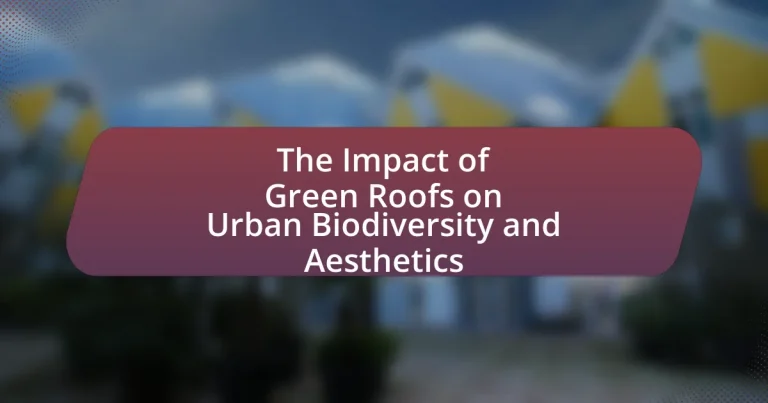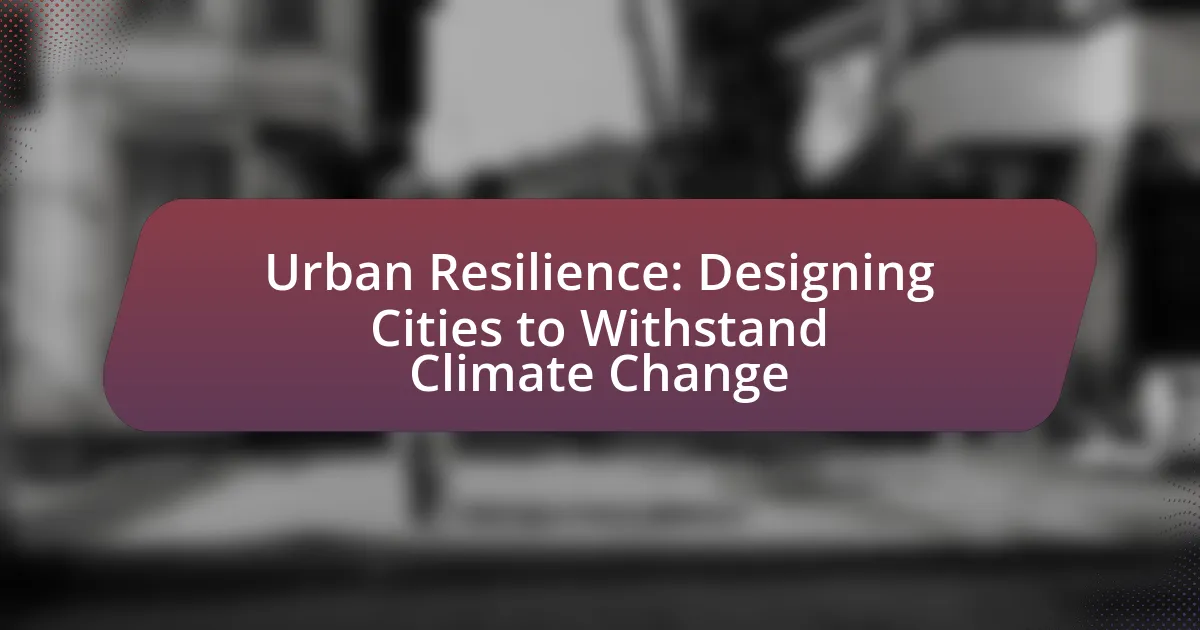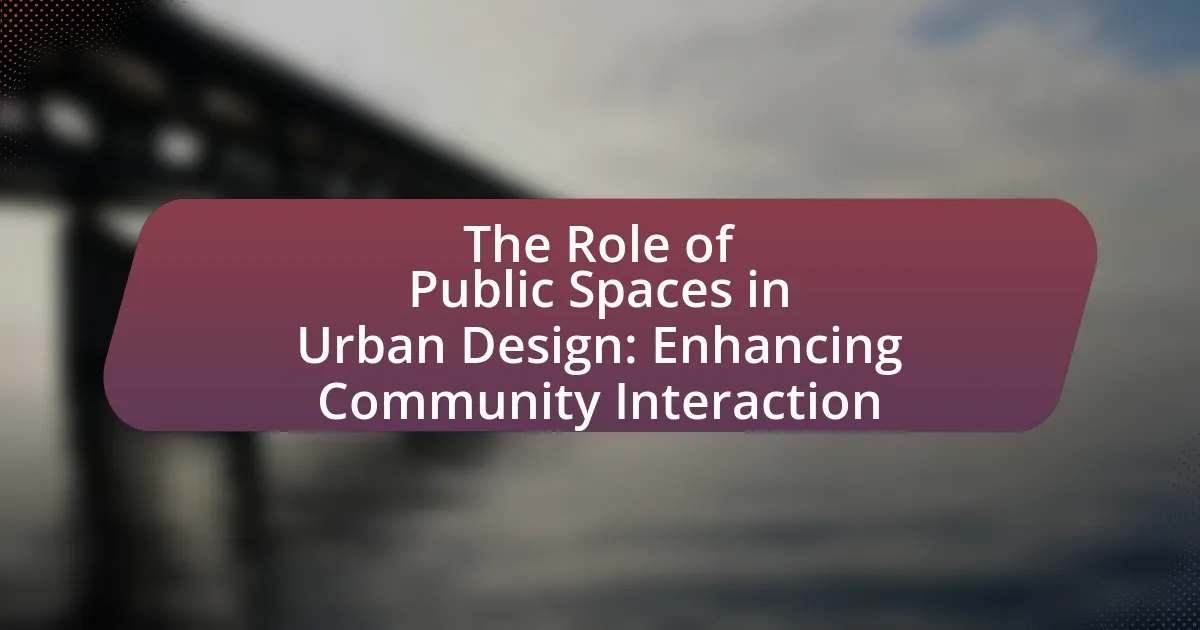Green roofs are vegetated systems installed on building rooftops that provide significant environmental benefits, including enhanced urban biodiversity, improved stormwater management, and reduced urban heat. This article explores the various types of green roofs, their contributions to urban ecosystems, and their role in supporting wildlife and pollinators. It also addresses the aesthetic advantages of green roofs, their impact on mental well-being, and the challenges associated with their implementation. Additionally, the article highlights best practices for maximizing the ecological and aesthetic benefits of green roofs, emphasizing the importance of community engagement and supportive policies in promoting their adoption in urban planning.
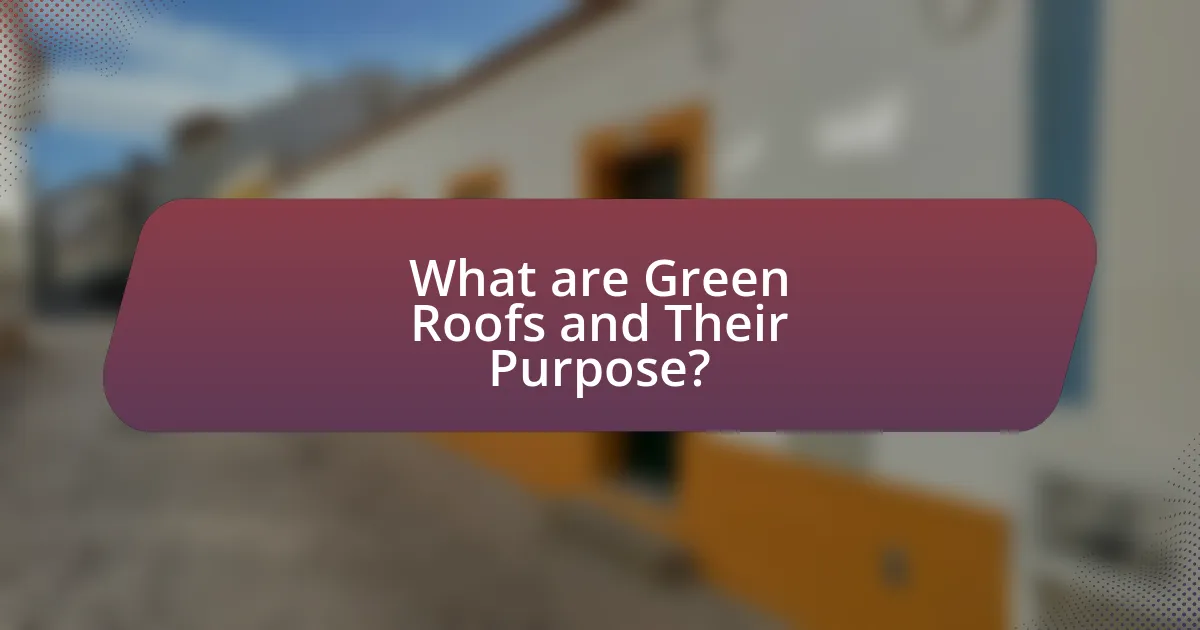
What are Green Roofs and Their Purpose?
Green roofs are vegetated systems installed on the rooftops of buildings, designed to support plant growth while providing various environmental benefits. Their primary purpose includes improving urban biodiversity by creating habitats for various species, enhancing stormwater management by absorbing rainwater, and reducing urban heat through insulation. Studies indicate that green roofs can lower ambient temperatures by up to 5 degrees Celsius, contributing to energy savings and improved air quality.
How do Green Roofs contribute to Urban Environments?
Green roofs contribute to urban environments by enhancing biodiversity, improving air quality, and reducing urban heat. They provide habitats for various species, including birds and insects, which are essential for pollination and ecological balance. Studies show that green roofs can support up to 30 different plant species and attract wildlife, thereby increasing urban biodiversity. Additionally, green roofs help filter pollutants from the air, leading to improved air quality, and they mitigate the urban heat island effect by lowering surface temperatures, which can be up to 5 degrees Celsius cooler than conventional roofs. This cooling effect not only benefits the environment but also reduces energy consumption for cooling buildings.
What are the different types of Green Roofs?
There are two main types of green roofs: extensive and intensive. Extensive green roofs are characterized by a shallow growing medium, typically 2 to 6 inches deep, and are designed for low maintenance with drought-resistant plants. Intensive green roofs, on the other hand, have a deeper growing medium, usually over 6 inches, allowing for a wider variety of plants, including shrubs and small trees, but require more maintenance and irrigation. These distinctions are crucial for understanding their applications in urban environments, as extensive roofs are often used for their lightweight and low-cost benefits, while intensive roofs provide greater biodiversity and aesthetic appeal.
How do Green Roofs function in urban settings?
Green roofs function in urban settings by providing a layer of vegetation on building rooftops, which helps to mitigate urban heat, manage stormwater, and enhance biodiversity. This vegetation absorbs rainwater, reducing runoff and decreasing the burden on urban drainage systems, which is particularly important in densely populated areas where impervious surfaces dominate. Studies indicate that green roofs can reduce surface temperatures by up to 40% compared to conventional roofs, contributing to lower energy consumption for cooling. Additionally, they create habitats for various species, promoting urban biodiversity; for instance, a study published in the journal “Urban Ecology” found that green roofs can support a range of plant and animal species, thereby enhancing the ecological value of urban environments.
Why are Green Roofs important for Biodiversity?
Green roofs are important for biodiversity because they provide essential habitats for various plant and animal species in urban environments. These green spaces support pollinators, such as bees and butterflies, by offering food sources and nesting sites, which are often scarce in cities. Research indicates that green roofs can host a diverse range of species; for instance, a study published in the journal “Ecological Engineering” found that green roofs can support up to 30 different plant species and numerous invertebrates, contributing to urban ecological networks. By enhancing habitat availability, green roofs play a crucial role in promoting biodiversity in densely populated areas.
What species benefit from Green Roofs?
Green roofs benefit a variety of species, including birds, insects, and plants. These ecosystems provide habitats and food sources, enhancing urban biodiversity. For instance, studies have shown that green roofs can support pollinators like bees and butterflies, which are crucial for plant reproduction. Additionally, specific bird species, such as sparrows and finches, utilize green roofs for nesting and foraging. Research indicates that green roofs can host over 150 species of plants, contributing to the overall ecological health of urban areas.
How do Green Roofs support pollinators and other wildlife?
Green roofs support pollinators and other wildlife by providing essential habitats and food sources in urban environments. These green spaces create diverse ecosystems that attract various species, including bees, butterflies, and birds, which rely on the plants for nectar and shelter. Research indicates that green roofs can increase local biodiversity by offering a variety of plant species that bloom at different times, thus extending the availability of resources for pollinators throughout the growing season. For instance, a study published in the journal “Ecological Engineering” found that green roofs can host up to 30 different plant species, significantly enhancing habitat complexity and supporting a wider range of wildlife.
What aesthetic benefits do Green Roofs provide?
Green roofs provide significant aesthetic benefits by enhancing urban landscapes and promoting biodiversity. They create visually appealing green spaces that can soften the harshness of built environments, contributing to improved mental well-being for residents. Studies indicate that green roofs can increase property values by up to 15% due to their attractive appearance and the added greenery they provide. Additionally, they support diverse plant species, which can attract pollinators and other wildlife, further enriching the urban ecosystem. This combination of visual appeal and ecological support underscores the multifaceted aesthetic advantages of green roofs in urban settings.
How do Green Roofs enhance urban landscapes?
Green roofs enhance urban landscapes by providing green spaces that improve aesthetics, biodiversity, and environmental quality. These roofs create habitats for various plant and animal species, contributing to urban biodiversity; for instance, studies have shown that green roofs can support up to 30 different species of plants and attract pollinators like bees and butterflies. Additionally, green roofs help mitigate urban heat islands by reducing surface temperatures, which can lower energy consumption for cooling buildings. They also manage stormwater by absorbing rainwater, thus reducing runoff and improving water quality. Overall, the integration of green roofs into urban environments leads to more sustainable and visually appealing cities.
What role do Green Roofs play in improving mental well-being?
Green roofs significantly enhance mental well-being by providing access to green spaces, which have been shown to reduce stress and improve mood. Studies indicate that exposure to nature, even in urban settings, can lead to lower levels of anxiety and depression. For instance, research published in the Journal of Environmental Psychology found that individuals who interact with green environments report higher levels of happiness and life satisfaction. Additionally, green roofs contribute to improved air quality and reduced urban heat, creating a more pleasant living environment that further supports mental health.
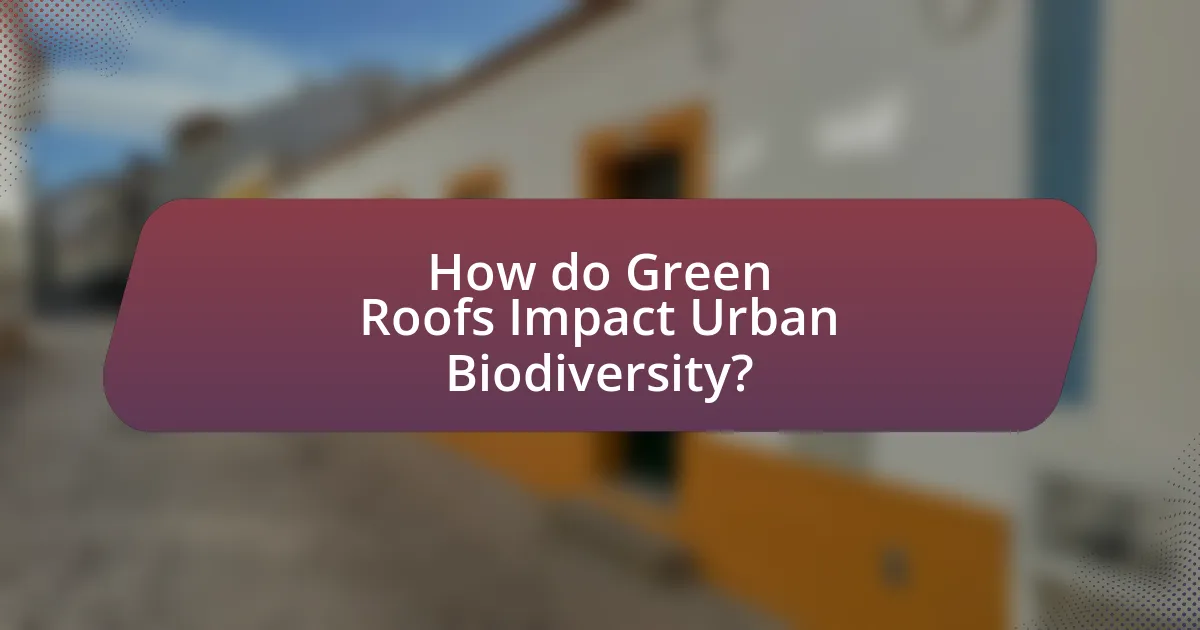
How do Green Roofs Impact Urban Biodiversity?
Green roofs significantly enhance urban biodiversity by providing habitats for various plant and animal species. These green spaces create micro-ecosystems that support pollinators, birds, and other wildlife, which are often scarce in urban environments. Research indicates that green roofs can host a diverse range of flora, with studies showing that they can support up to 150 different plant species, thereby increasing local biodiversity. Additionally, green roofs contribute to the connectivity of green spaces in cities, allowing for wildlife movement and promoting ecological resilience.
What specific biodiversity benefits do Green Roofs offer?
Green roofs provide significant biodiversity benefits by creating habitats for various plant and animal species in urban environments. These green spaces support pollinators, such as bees and butterflies, by offering food sources and nesting sites, which are crucial for their survival in increasingly urbanized areas. Research indicates that green roofs can host a diverse range of flora, with studies showing that they can support up to 150 different plant species, enhancing local biodiversity. Additionally, green roofs contribute to the overall ecological network by connecting fragmented habitats, allowing for species movement and genetic exchange, which is vital for maintaining healthy populations.
How do Green Roofs create habitats for urban wildlife?
Green roofs create habitats for urban wildlife by providing vegetation and structural complexity that support various species. The diverse plant life on green roofs offers food sources, such as nectar and seeds, which attract pollinators like bees and butterflies. Additionally, the layers of soil and plants create microhabitats that can host insects, birds, and small mammals. Research indicates that green roofs can increase local biodiversity; for instance, a study published in the journal “Ecological Engineering” found that green roofs can support up to 30 different plant species and various animal species, enhancing urban ecosystems.
What is the role of native plants in Green Roofs?
Native plants play a crucial role in green roofs by enhancing biodiversity and promoting ecosystem services. They provide habitat and food sources for local wildlife, including pollinators, which are essential for urban ecosystems. Research indicates that green roofs with native vegetation support a higher diversity of insects and birds compared to those with non-native species. Additionally, native plants are adapted to local climate conditions, requiring less water and maintenance, which contributes to the sustainability of green roofs. Studies have shown that incorporating native plants can improve stormwater management and reduce urban heat, further validating their importance in urban biodiversity and aesthetics.
How do Green Roofs influence ecosystem services?
Green roofs enhance ecosystem services by improving biodiversity, managing stormwater, and regulating urban temperatures. These green spaces provide habitats for various species, contributing to urban biodiversity; studies show that green roofs can support up to 30 different plant species and attract pollinators like bees and butterflies. Additionally, they effectively absorb rainwater, reducing runoff and mitigating flooding, with some systems capable of retaining up to 80% of precipitation. Furthermore, green roofs help lower ambient temperatures through evapotranspiration, which can reduce the urban heat island effect by as much as 5 degrees Celsius.
What ecosystem services are enhanced by Green Roofs?
Green roofs enhance several ecosystem services, including stormwater management, urban heat island mitigation, air quality improvement, and biodiversity support. Stormwater management is improved as green roofs absorb rainwater, reducing runoff and decreasing the risk of flooding. Studies show that green roofs can retain up to 75% of rainfall, significantly alleviating pressure on urban drainage systems. Urban heat island mitigation occurs because vegetation cools the surrounding air through evapotranspiration, leading to lower temperatures in urban areas. Air quality is enhanced as plants filter pollutants and carbon dioxide, contributing to cleaner air. Additionally, green roofs provide habitats for various species, promoting urban biodiversity by supporting pollinators and other wildlife. Research indicates that green roofs can host up to 30 different plant species, fostering ecological diversity in urban settings.
How do Green Roofs contribute to urban resilience?
Green roofs contribute to urban resilience by enhancing stormwater management, reducing urban heat, and improving air quality. These systems absorb rainwater, which mitigates flooding and decreases the burden on drainage systems during heavy rainfall. Studies indicate that green roofs can retain up to 80% of rainfall, significantly reducing runoff. Additionally, they lower ambient temperatures by providing insulation and reducing the urban heat island effect, which can lead to energy savings and improved comfort for residents. Furthermore, green roofs filter pollutants from the air, contributing to better air quality and promoting public health.
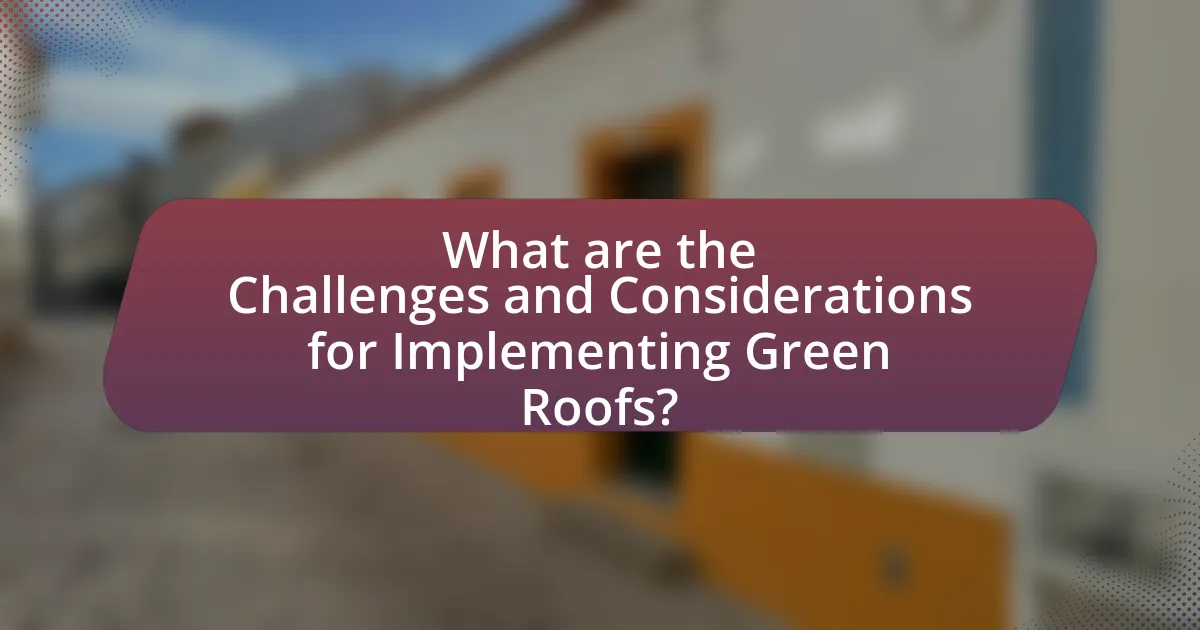
What are the Challenges and Considerations for Implementing Green Roofs?
The challenges and considerations for implementing green roofs include structural load capacity, plant selection, maintenance requirements, and initial costs. Structural load capacity is critical, as roofs must support the weight of soil and vegetation; studies indicate that green roofs can add 15 to 50 pounds per square foot, necessitating engineering assessments. Plant selection is vital for ensuring sustainability and biodiversity; native species are often recommended to enhance local ecosystems. Maintenance requirements can be significant, as green roofs need regular care to thrive, including irrigation and weeding. Initial costs can be high, with installation expenses ranging from $10 to $25 per square foot, which may deter some property owners despite long-term benefits such as energy savings and stormwater management.
What are the common barriers to Green Roof installation?
Common barriers to Green Roof installation include high initial costs, structural limitations, and lack of awareness or knowledge among stakeholders. High initial costs can deter property owners, as installation and maintenance expenses often exceed traditional roofing options. Structural limitations arise when existing buildings cannot support the additional weight of a green roof, necessitating costly reinforcements. Additionally, a lack of awareness or knowledge about the benefits and maintenance of green roofs can lead to hesitancy in adoption, as potential users may not fully understand their ecological and aesthetic advantages.
How can costs be managed in Green Roof projects?
Costs in Green Roof projects can be managed through careful planning, selection of materials, and maintenance strategies. Effective project management involves conducting a thorough cost-benefit analysis to identify the most cost-effective design and plant selection, which can reduce initial investment and long-term maintenance costs. Utilizing native plants can lower irrigation and maintenance expenses, as they are better adapted to local climates. Additionally, implementing modular green roof systems can simplify installation and reduce labor costs. Research indicates that well-planned green roofs can yield energy savings of up to 30% by improving insulation, further offsetting costs over time.
What maintenance practices are essential for Green Roofs?
Essential maintenance practices for green roofs include regular inspections, irrigation management, weeding, and fertilization. Regular inspections help identify issues such as plant health, drainage problems, and structural integrity, ensuring the longevity of the green roof. Irrigation management is crucial, particularly in dry periods, to maintain plant health and prevent drought stress. Weeding is necessary to control invasive species that can outcompete desired plants, while fertilization provides essential nutrients to support plant growth and biodiversity. Studies indicate that proper maintenance can enhance the ecological benefits of green roofs, contributing positively to urban biodiversity and aesthetics.
How can urban planners effectively integrate Green Roofs?
Urban planners can effectively integrate green roofs by incorporating them into zoning regulations and building codes, ensuring that new developments include green roof systems. This integration can enhance urban biodiversity by providing habitats for various species, as studies show that green roofs can support a diverse range of flora and fauna, contributing to overall ecosystem health. Additionally, planners can incentivize green roof installations through tax breaks or grants, which has been shown to increase adoption rates in urban areas. For instance, cities like Toronto have implemented policies that require green roofs on new buildings, resulting in a significant increase in green space and improved urban aesthetics.
What policies support the development of Green Roofs?
Policies that support the development of green roofs include zoning regulations, building codes, and financial incentives. Zoning regulations often allow for increased density or height in exchange for incorporating green roofs, while building codes may mandate green roof installation for certain types of buildings. Financial incentives, such as grants or tax credits, encourage property owners to invest in green roofs by offsetting installation costs. For example, cities like Toronto have implemented a Green Roof Bylaw that requires green roofs on new developments, demonstrating a legislative framework that promotes this sustainable practice.
How can community engagement enhance Green Roof initiatives?
Community engagement can enhance Green Roof initiatives by fostering local ownership and participation, which leads to increased support and maintenance of these projects. Engaged communities are more likely to advocate for green spaces, resulting in better funding and resources for Green Roof installations. Studies show that when residents are involved in the planning and implementation of Green Roofs, such as in the case of the Chicago Green Roof Initiative, the projects not only meet ecological goals but also reflect the community’s aesthetic preferences and needs. This collaboration can improve biodiversity by ensuring that the plant selections are suitable for local wildlife, thus enhancing the ecological benefits of Green Roofs.
What are best practices for maximizing the benefits of Green Roofs?
To maximize the benefits of green roofs, it is essential to select appropriate plant species that are native and drought-resistant, as these plants enhance biodiversity and require less maintenance. Research indicates that native plants support local wildlife, including pollinators, which contributes to urban biodiversity. Additionally, implementing a multi-layered design that includes a waterproof membrane, drainage layer, and growing medium can optimize water retention and reduce runoff, thereby improving stormwater management. Studies show that green roofs can reduce urban heat island effects by lowering ambient temperatures, which is crucial for enhancing urban aesthetics and energy efficiency. Regular maintenance, including weeding and irrigation during dry spells, ensures the longevity and health of the green roof, further maximizing its ecological and aesthetic benefits.
